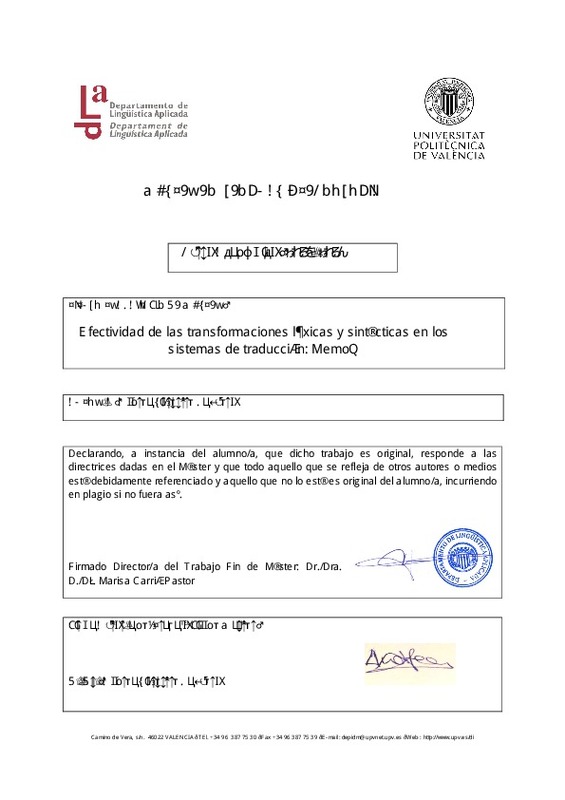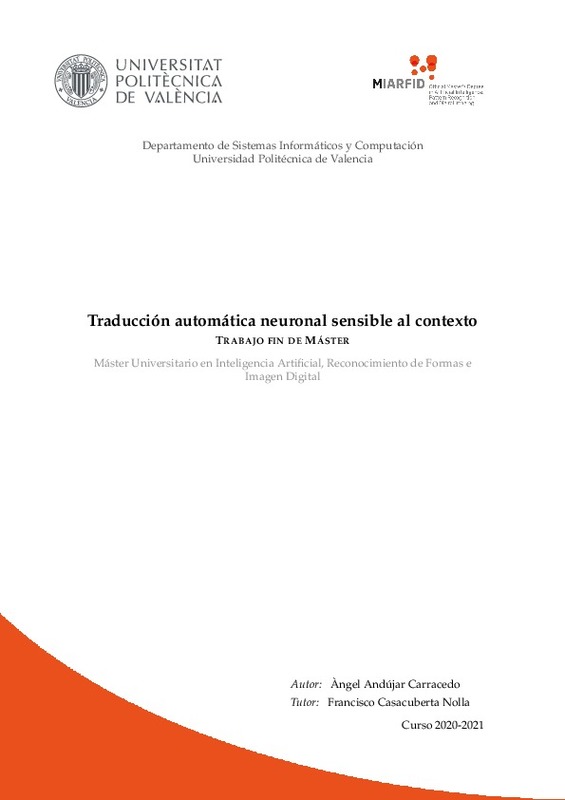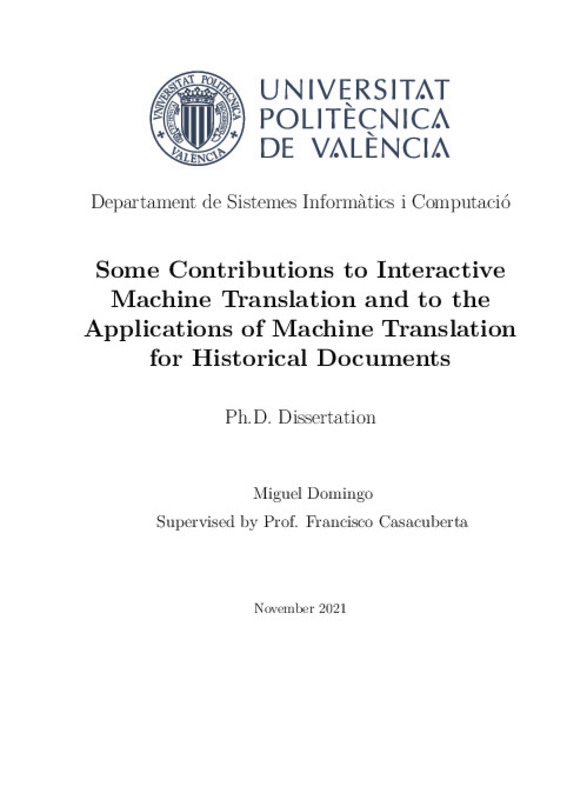JavaScript is disabled for your browser. Some features of this site may not work without it.
Buscar en RiuNet
Listar
Mi cuenta
Estadísticas
Ayuda RiuNet
Admin. UPV
Efectividad de las transformaciones léxicas y sintácticas en los sistemas de memoria de traducción: memoq
Mostrar el registro sencillo del ítem
Ficheros en el ítem
| dc.contributor.advisor | Carrió Pastor, Mª Luisa
|
es_ES |
| dc.contributor.author | Silvestre Baquero, Andrea
|
es_ES |
| dc.date.accessioned | 2017-10-27T12:46:03Z | |
| dc.date.available | 2017-10-27T12:46:03Z | |
| dc.date.created | 2017-09-29 | |
| dc.date.issued | 2017-10-27 | es_ES |
| dc.identifier.uri | http://hdl.handle.net/10251/90174 | |
| dc.description.abstract | The present work is framed within the studies of translation, specifically, as far as the computer assisted translation (TAO) is concerned. Within this field, our study is focused on the translation memories (MT), whose current exponents are Mitkov (2005) and Orasan (2015), both belonging to the Research Group on Computational Linguistics (RGCL) of the University of Wolverhampton. The main objective to carry out this work is based on the need to verify if the TMs are sufficiently functional to detect changes produced at the semantic and syntactic level and to really help the translator or if, on the contrary, to new approaches. Among the secondary objectives of the work, we can highlight: design a corpus that can be used to implement in other MT or even be used as an aid resource, create templates to examine other MT and implement the results obtained in a system applicable in other works related to the same line of research. Our work will consist of creating a parallel Spanish / English corpus with approximately 150 segments of a length between 5 and 25 words. The corpus has been compiled with authentic and real documents in both languages ¿¿(Spanish-English) with a legislative theme so that the lexicon is not very complicated and the sentences are not excessively long, and thus allow us to achieve the greatest number of transformations possible. The documents have been taken from the websites of the European Union and the United Nations, respectively. We have manually aligned the corpus so that we could have the sentences faced and extracted the 150 that we considered most appropriate for the experiment. Once we have the sentences, we have selected 10 semantic and syntactic rules to apply to sentences. The next step is to upload the original corpus to the translation tool, this MemoQ case, and later translate the transformed sentences to see statistically what coincidence we find with the original sentences. Our initial research hypothesis is that the coincidence percentage will be reduced after performing the transformations of the original sentences compiled in the MT. We expect that the results show the need for improved translation memories, since the statistics must show the semantic deficit that exists and, therefore, the need to implement the translation memories. This, in the long term, can mean an evolution in TM and therefore a greater foothold than the translators can use. In addition, it may also mean the need to introduce natural language processing (PLN) to obtain a substantial improvement of systems, for example the use of paraphrasing or parsing (grammar analysis). Finally, it is noteworthy to mention that although this study is very concrete, we hope that in the consequent it can be applied in other translation tools and in other linguistic combinations. It would even be possible to increase the corpus of research and to search for more varied topics that may have greater applicability. | es_ES |
| dc.description.abstract | El presente trabajo se encuentra enmarcado dentro de los estudios de traducción,concretamente, en lo relativo a la traducción asistida por ordenador (TAO). Dentro de este propio campo, nuestro estudio está enfocado hacia las memorias de traducción (MT), cuyos máximos exponentes en la actualidad son Mitkov (2005) y Orasan (2015), ambos pertenecientes al Grupo de Investigación de Lingüística Computacional (RGCL) de la Universidad de Wolverhampton. El objetivo principal para llevar a cabo este trabajo se basa en la necesidad de comprobar si las MT son suficientemente funcionales como para detectar cambios producidos a nivel semántico y sintáctico y servir realmente de ayuda al traductor o si por el contrario, hay que adecuar las MT a nuevos enfoques. Entre los objetivos secundarios del trabajo, podemos destacar: diseñar un corpus que pueda servir para implementarse en otras MT o incluso utilizarse como recurso de ayuda, crear plantillas para examinar otras MT e implementar los resultados obtenidos en un sistema aplicable en otros trabajos relacionados con la misma línea de investigación. Nuestro trabajo consistirá en crear un corpus paralelo español/inglés con aproximadamente 150 segmentos de una longitud entre 5 y 25 palabras. El corpus ha sido compilado con documentos auténticos y reales en ambos idiomas (español-inglés) con una temática de carácter legislativo para que el léxico no resultara muy complicado y las oraciones no fueran excesivamente largas, y así, permitirnos conseguir el mayor número de transformaciones posibles. Los documentos han sido extraídos de las páginas web de la Unión Europea y de las Naciones unidas, respectivamente. El corpus lo hemos alineado manualmente, para que pudiéramos tener las oraciones enfrentadas y hemos extraído las 150 que hemos considerado más apropiadas para el experimento. Una vez tenemos las oraciones, hemos seleccionado 10 reglas semánticas y sintácticas para aplicar a las oraciones. El paso siguiente es subir el corpus original a la herramienta de traducción, este caso MemoQ, y traducir posteriormente las oraciones transformadas para ver estadísticamente que coincidencia encontramos con las frases originales. Nuestra hipótesis de investigación de partida es que el porcentaje de coincidencia se verá reducido después de realizar las transformaciones de las oraciones originales compiladas en la MT. Esperamos que los resultados muestren la necesidad de mejora de las memorias de traducción, ya que las estadísticas deben mostrar el déficit semántico que existe y por tanto, la necesidad de implementar las memorias de traducción. Esto, a largo plazo, puede significar una evolución en las MT y por tanto un punto de apoyo mayor al que los traductores podrán recurrir. Además, también puede significar la necesidad de introducir el procesamiento del lenguaje natural (PLN) para obtener una mejora sustancial de los sistemas, por ejemplo el uso de paráfrasis o parsing (análisis gramatical). Por último, es destacable mencionar que aunque este estudio es muy concreto, esperamos que en lo consiguiente pueda ser aplicado en otras herramientas de traducción y en otras combinaciones lingüísticas. Incluso sería posible aumentar el corpus de investigación y buscar temáticas más variadas que puedan tener mayor aplicabilidad. | es_ES |
| dc.language | Español | es_ES |
| dc.publisher | Universitat Politècnica de València | es_ES |
| dc.rights | Reserva de todos los derechos | es_ES |
| dc.subject | natural language processing | es_ES |
| dc.subject | Computer -assisted translation | es_ES |
| dc.subject | Translation memory | es_ES |
| dc.subject | Applied linguistics | es_ES |
| dc.subject | Lingüística aplicada; memoria de traducción; traducción asistida por ordenador; procesamiento del lenguaje natural. | es_ES |
| dc.subject | Lingüística aplicada | es_ES |
| dc.subject | Memoria de traducción | es_ES |
| dc.subject | Traducción asistida por ordenador | es_ES |
| dc.subject | Procesamiento del lenguaje natural | es_ES |
| dc.subject.classification | FILOLOGIA INGLESA | es_ES |
| dc.subject.other | Máster Universitario en Lenguas y Tecnología-Màster Universitari en Llengües i Tecnologia | es_ES |
| dc.title | Efectividad de las transformaciones léxicas y sintácticas en los sistemas de memoria de traducción: memoq | es_ES |
| dc.type | Tesis de máster | es_ES |
| dc.rights.accessRights | Abierto | es_ES |
| dc.contributor.affiliation | Universitat Politècnica de València. Departamento de Lingüística Aplicada - Departament de Lingüística Aplicada | es_ES |
| dc.description.bibliographicCitation | Silvestre Baquero, A. (2017). Efectividad de las transformaciones léxicas y sintácticas en los sistemas de memoria de traducción: memoq. http://hdl.handle.net/10251/90174 | es_ES |
| dc.description.accrualMethod | TFGM | es_ES |
| dc.relation.pasarela | TFGM\73114 | es_ES |









